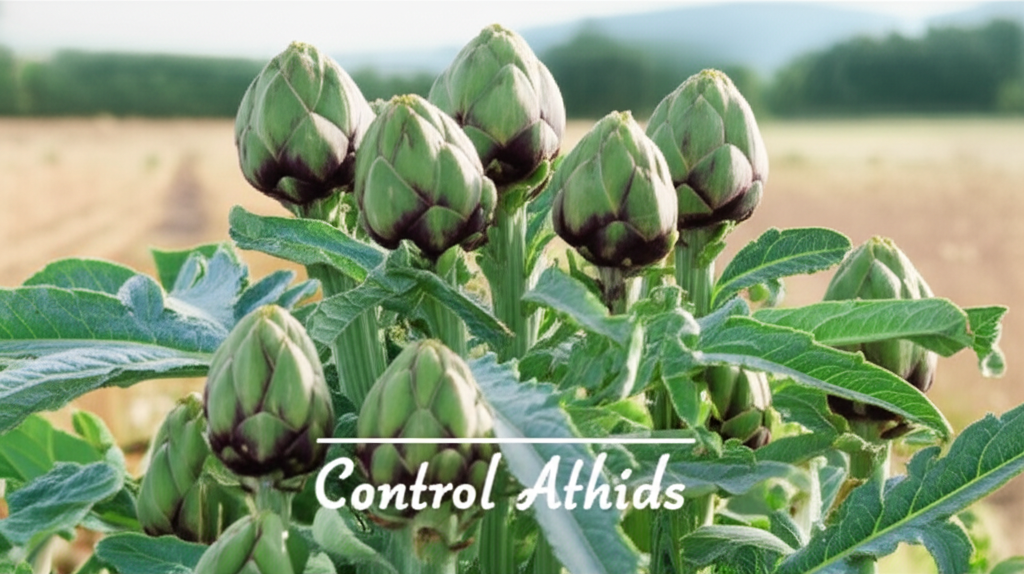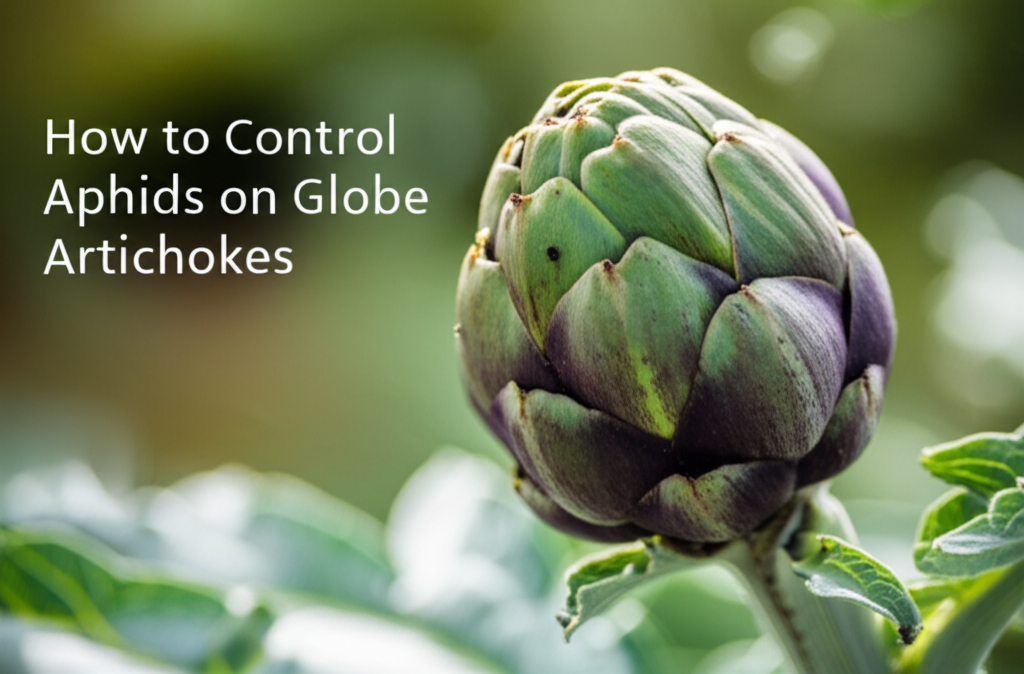Aphids are a gardener’s nemesis, and globe artichokes, with their succulent new growth, are particularly susceptible to their insidious invasion. These tiny sap-sucking insects can quickly debilitate your plants, leading to stunted growth, deformed leaves, and a significantly reduced harvest. But fear not, intrepid artichoke enthusiast! This comprehensive guide will equip you with the knowledge and strategies to effectively control aphids on your globe artichokes, ensuring a bountiful and healthy yield.
Understanding the Aphid Threat to Globe Artichokes
Before we delve into control methods, it’s crucial to understand what we’re up against. Aphids are small, soft-bodied insects that typically congregate in clusters on the undersides of leaves, along stems, and on developing flower buds. They come in a variety of colors, including green, black, brown, yellow, and pink.
How Aphids Damage Globe Artichokes
Aphids feed by piercing plant tissues with their sharp mouthparts and extracting sap. This process directly deprives the artichoke plant of vital nutrients and sugars. The consequences of aphid infestation include:
- Stunted Growth: The plant’s energy is diverted to fighting off the infestation and producing more aphids, rather than focusing on healthy vegetative growth.
- Yellowing and Wilting Leaves: Sap depletion weakens the leaves, causing them to turn yellow and eventually wilt.
- Deformed Buds and Flowers: Aphids can distort the development of the edible flower buds, rendering them unmarketable or unpalatable.
- Honeydew Production: As aphids feed, they excrete a sticky, sugary substance called honeydew. This honeydew can attract ants, which, unfortunately, often “farm” aphids for their sugary waste.
- Sooty Mold: The honeydew also provides a perfect substrate for the growth of sooty mold, a black fungus that can further inhibit photosynthesis and weaken the plant.
- Virus Transmission: Aphids are notorious vectors for plant viruses, which can cause further damage and potentially kill the plant.
Identifying Aphids on Your Artichokes
Early detection is key to successful aphid control. Regularly inspect your globe artichoke plants, paying close attention to:
- The undersides of leaves, especially new growth.
- The developing flower buds.
- The tips of stems.
- Look for small, pear-shaped insects, often in clusters.
- Observe the presence of sticky honeydew or the black sooty mold.
- You may also notice ants actively crawling on the plants, a tell-tale sign of an aphid infestation.
Key Facts and Comparison of Aphid Control Methods

Choosing the right aphid control method depends on the severity of the infestation, your gardening philosophy (organic vs. conventional), and your available resources. Here’s a comparison of common approaches:
| Method | Description | Effectiveness | Pros | Cons |
|---|---|---|---|---|
| Physical Removal | Manually removing aphids by hand or with a strong spray of water. | Effective for light infestations; requires diligence. | Organic, no chemical residue, immediate impact. | Labor-intensive for large infestations; may not reach all aphids. |
| Insecticidal Soap | Specially formulated soaps that break down the aphid’s outer shell. | Highly effective on contact; works best on young aphids. | Organic, relatively safe for beneficial insects, quick knockdown. | Requires direct contact with aphids, can damage some sensitive plants if applied improperly (e.g., in direct sun or high heat). |
| Neem Oil | Derived from the neem tree, it acts as an antifeedant, growth regulator, and repels aphids. | Effective for both prevention and control; disrupts aphid life cycle. | Organic, broad-spectrum action, also acts as a fungicide. | Can be harmful to beneficial insects if not applied carefully, may cause leaf burn if applied in direct sunlight or high temperatures. |
| Horticultural Oil | Covers and suffocates soft-bodied insects. | Effective on contact; works well on various life stages. | Organic, relatively inexpensive, can control other pests. | Can damage plants if applied at the wrong temperature or concentration; can harm beneficial insects. |
| Beneficial Insects | Introducing natural predators like ladybugs, lacewings, and parasitic wasps. | Effective for long-term, sustainable control; requires patience. | Organic, environmentally friendly, addresses the root cause. | May take time to establish, effectiveness can vary, less immediate than sprays. |
| Chemical Insecticides | Synthetic pesticides designed to kill insects. | Fast-acting and highly effective for severe infestations. | Quick and potent knockdown. | Can harm beneficial insects, pollinators, and the environment; potential for resistance development; residue concerns. |
Integrated Pest Management (IPM) for Globe Artichokes
The most effective and sustainable approach to controlling aphids on globe artichokes is through Integrated Pest Management (IPM). IPM is a holistic strategy that combines multiple methods to manage pests while minimizing the use of harsh chemicals. It emphasizes prevention, monitoring, and the use of the least toxic methods first.
Cultural Controls: Setting the Stage for Success
Prevention is always better than cure. Implementing sound cultural practices can significantly reduce the likelihood of severe aphid infestations.
- Healthy Soil: Provide your artichoke plants with nutrient-rich, well-draining soil. Healthy plants are more resilient to pest attacks.
- Proper Watering: Water your artichokes deeply and consistently, especially during dry periods. Avoid overhead watering, which can create conditions favorable for some pests.
- Weed Control: Keep the area around your artichokes free of weeds, as many weeds can host aphid populations.
- Crop Rotation: While globe artichokes are perennials, rotating where you plant them in your garden each year can help break pest cycles.
- Attract Beneficial Insects: Plant companion plants that attract natural aphid predators. Examples include dill, fennel, yarrow, and marigolds.
- Avoid Over-Fertilization: Excessive nitrogen fertilizer can promote lush, tender new growth that is highly attractive to aphids.
Mechanical and Physical Controls: The First Line of Defense
When you spot those first tell-tale signs of aphids, it’s time for immediate action with mechanical and physical controls.
- Water Spray: A strong blast of water from your garden hose can dislodge aphids from the plants. Do this early in the morning so the leaves have time to dry.
- Handpicking: For small infestations, carefully pick off aphids by hand and drop them into a bucket of soapy water.
- Pruning: If a particular stem or leaf cluster is heavily infested, you can prune it off and dispose of it properly.
Biological Controls: Enlisting Nature’s Allies
Harnessing the power of beneficial insects is a cornerstone of organic aphid control.
- Ladybugs (Coccinellidae): These voracious aphid predators are a gardener’s best friend. You can attract them by planting dill, fennel, and yarrow. You can also purchase ladybugs online or at garden centers.
- Lacewings (Neuroptera): Both the larvae and adults of lacewings are effective aphid predators. Their larvae are particularly voracious.
- Hoverflies (Syrphidae): Also known as flower flies, their larvae are excellent aphid predators. Planting plants like alyssum and coriander can attract adult hoverflies.
- Parasitic Wasps (Hymenoptera): These tiny wasps lay their eggs inside aphids, eventually killing them. Their presence is often indicated by “mummified” aphids (swollen, discolored aphids).
Step-by-Step Guide to Aphid Control
Here’s a systematic approach to tackling aphid infestations on your globe artichokes:
| Step | Action | Details |
|---|---|---|
| 1. Monitor Regularly | Inspect your artichoke plants frequently. | Check undersides of leaves, stems, and buds for aphids, honeydew, or ants. Early detection is crucial. |
| 2. Initial Mechanical Removal | Use water spray or handpicking. | For small infestations, blast with water or pick them off manually. Dispose of them properly. |
| 3. Apply Organic Sprays (if needed) | Use insecticidal soap or neem oil. | Thoroughly coat all infested areas. Apply in the early morning or late evening to avoid harming beneficial insects or causing leaf scorch. Reapply as needed, following product instructions. |
| 4. Encourage Beneficial Insects | Plant attractant flowers or release purchased beneficials. | Create a welcoming habitat for ladybugs, lacewings, and hoverflies. This is a long-term strategy. |
| 5. Manage Ants | Prevent ants from protecting aphids. | Ants often protect aphids from predators in exchange for honeydew. Use ant baits or sticky barriers around plant stems. |
| 6. Consider Horticultural Oil | For persistent or moderate infestations. | Use dormant or summer horticultural oil according to product instructions. Ensure proper application to avoid plant damage. |
| 7. Resort to Chemical Insecticides (as a last resort) | Use only when other methods fail. | Select an insecticide specifically labeled for aphid control on vegetables. Always follow label directions carefully for application rates, timing, and safety precautions. Be aware of potential impacts on beneficial insects and pollinators. |
Organic Aphid Control Methods Explained
When you decide to go the organic route, these methods are highly effective and environmentally sound.
Insecticidal Soap
- How it works: Insecticidal soaps contain fatty acids that disrupt the cell membranes of soft-bodied insects like aphids, causing dehydration and death.
- Application: Purchase a commercial insecticidal soap or make your own by mixing 1 tablespoon of pure liquid soap (like Dr. Bronner’s unscented) with 1 quart of water.
- When to apply: Spray directly on aphids, ensuring thorough coverage, especially on the undersides of leaves. Repeat every 5-7 days as needed. Avoid spraying in direct sunlight or when temperatures exceed 85°F (29°C) to prevent leaf burn.
Neem Oil
- How it works: Neem oil is a natural pesticide derived from the neem tree. It acts as an antifeedant, growth regulator, and repellant. It disrupts the aphid’s hormonal system, preventing them from feeding and reproducing.
- Application: Use a high-quality, cold-pressed neem oil product. Mix according to label instructions, typically 1-2 tablespoons of neem oil and 1 teaspoon of mild liquid soap (as an emulsifier) per gallon of water.
- When to apply: Spray thoroughly on all infested parts of the plant, again, early morning or late evening is best. Reapply every 7-14 days as needed.
Horticultural Oil
- How it works: Horticultural oils (often called dormant oils or summer oils) work by suffocating insects. They form a thin film over the insect’s body, blocking their breathing pores.
- Application: Follow product instructions carefully for dilution rates. Different types of horticultural oils are formulated for different seasons and plant sensitivities.
- When to apply: Apply when temperatures are between 40°F (4°C) and 85°F (29°C) and when the plant is not under drought stress. Avoid applying during frost or extreme heat.
When to Consider Chemical Insecticides
While it’s ideal to avoid chemical insecticides, there may be instances of severe, rapidly spreading infestations where they become a necessary last resort.
- Choose wisely: Select products that are specifically labeled for aphid control on globe artichokes and are as targeted as possible.
- Read and follow labels meticulously: This includes application rates, frequency, pre-harvest intervals (the time between application and harvest), and safety precautions for yourself and the environment.
- Spot treatment: Apply insecticides only to the affected areas rather than broadcasting them over the entire plant or garden.
- Impact on beneficials: Be aware that many broad-spectrum insecticides will kill beneficial insects along with the pests.
- Resistance: Over-reliance on chemical insecticides can lead to aphid populations developing resistance, making the chemicals less effective over time.
Preventing Future Aphid Infestations
Once you’ve brought an aphid infestation under control, the goal is to prevent their return.
- Continuous Monitoring: Make regular inspections a habit, even when you don’t see any pests.
- Attract and Maintain Beneficial Insect Populations: Keep your garden diverse with flowering plants that attract natural predators.
- Keep Garden Tidy: Remove plant debris and weeds promptly, as these can harbor overwintering aphid eggs or provide shelter for pests.
- Observe New Plants: Inspect any new plants you bring into your garden for signs of pests before introducing them to your artichokes.
By implementing a comprehensive IPM strategy, focusing on prevention, diligent monitoring, and the appropriate use of control methods, you can successfully manage aphid populations and enjoy the delicious rewards of healthy, productive globe artichoke plants. Happy gardening!


